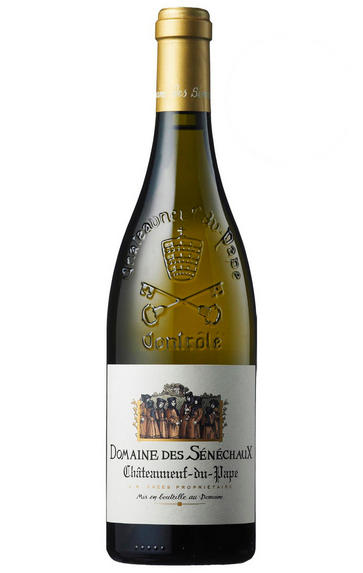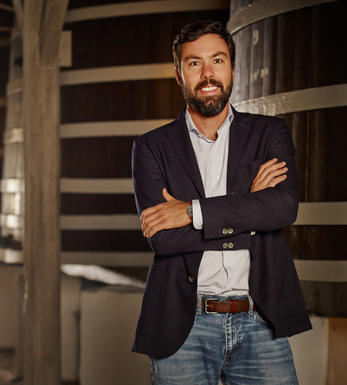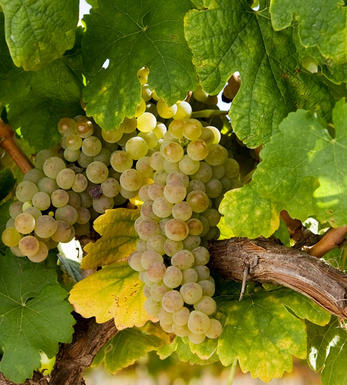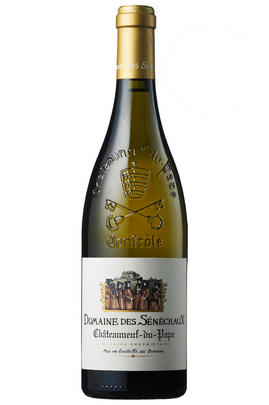
About this WINE

Domaine des Senechaux
Domaine des Sénéchaux is an excellent example of how a large concern – in this case the Cazes family of Château Lynch-Bages in Bordeaux – should manage its purchase by investing as and where necessary. They have done this without forsaking the historical essence of the domaine, personified by longstanding régisseur Bernard Tranchecoste. Domaine des Sénéchaux dates from the 14th century, making it one of the oldest wineries of the region. It spans 26 hectares across Châteauneuf-du-Pape, 23 of which are planted with red varieties, the remainder white. Their main holdings are on the south-westerly slopes of the Bois Sénéchaux, just to the east of the town of Châteauneuf-du-Pape. Here, some of their Grenache vines are as old as 90 years old. Production remains very traditional, and they retain a simple two-wine offering. Largely, grapes are de-stalked and new oak is avoided in favour of concrete, foudres and second-use Bordeaux (Lynch Bages) barrels.

Châteauneuf-du-Pape
The most celebrated village of the Southern Rhône, Châteauneuf-du-Pape is the birthplace of the now indispensable French Appellation d’Origine Contrôlée system – imperfect though it may be. Compared to the Northern Rhône, the vineyards here are relatively flat and often feature the iconic galet pebbles – the precise benefits of which are a source of much debate. Minimum alcohol levels required by the AOC are the highest in France, but at 12.5% it is well below the natural generosity of Grenache, which only achieves its full aromatic potential when it is fully ripe and laden with the resultant high sugars. Syrah and Mourvèdre contribute the other defining elements in the blend, adding pepper, savoury spice and structure to the decadent Grenache. There are a further 10 permitted red grape varieties which can be used to adjust the “seasoning”. Of the five white varieties permitted, it is Grenache Noir’s sibling – predictably perhaps – Grenache Blanc, which dominates, though Roussanne shows a great deal of promise when handled well, notably at Château de Beaucastel.

Roussanne
Roussanne is one of the most important white grape varieties in the Rhône Valley. It is a particularly pernickety grape to cultivate being a notoriously low yielder as well as being highly susceptible to rot. It is difficult to ripen, and seemingly prone to oxidation at every opportunity. Roussanne's name comes from its russet-coloured skin and it produces richly aromatic wines, often with fruit characteristics of lime and blossom.
In the northern Rhône it is typically blended with Marsanne to produce the white wines of Hermitage, Crozes-Hermitage, St-Joseph, and St-Péray. Generally Marsanne is the dominant partner and it lends colour, body and weight to the blend, as well as richly scented fruit, while Roussanne contributes bouquet, delicacy and finesse.
It is grown less extensively in the southern Rhône although it is one of the permitted varieties in Châteauneuf-du-Pape. There are plantings of Roussanne in the Languedoc and Rousillon and in the last decade the grape have been cultivated with particular success in California, where it is produced both as a single varietal and as a component of Rhône-style blends.



Buying options
Add to wishlist
Description
This blend of 34% Roussane, 30% Clairette, 28% Grenache Blanc and 8% Bourboulenc comes from 3ha south-westerly plots and sandy-clay soils. There is a gently tropical nose with notes of quince, pineapple and kiwi. There is some texture on the palate alongside ripe apricots, albeit tempered by a hint of bitter almond and a delicate white flower finish.
Drink now to 2029
Berry Bros. & Rudd
wine at a glance
Delivery and quality guarantee